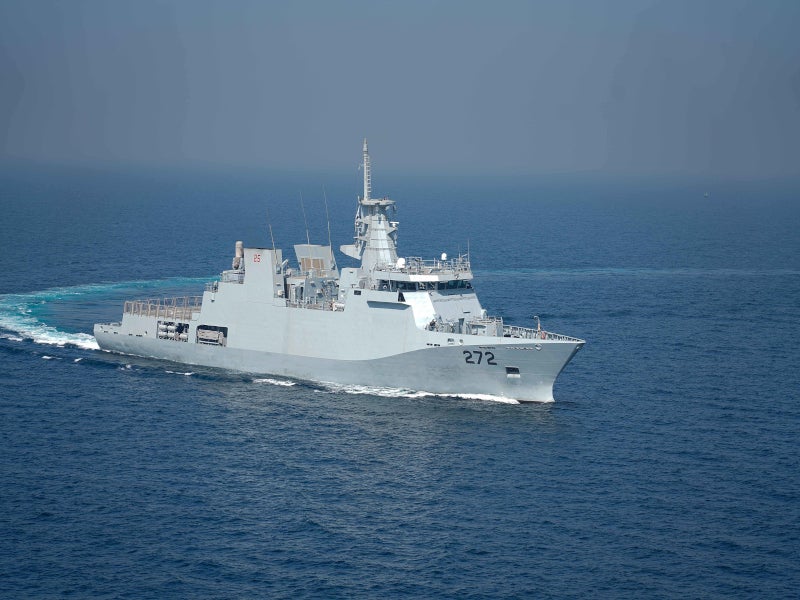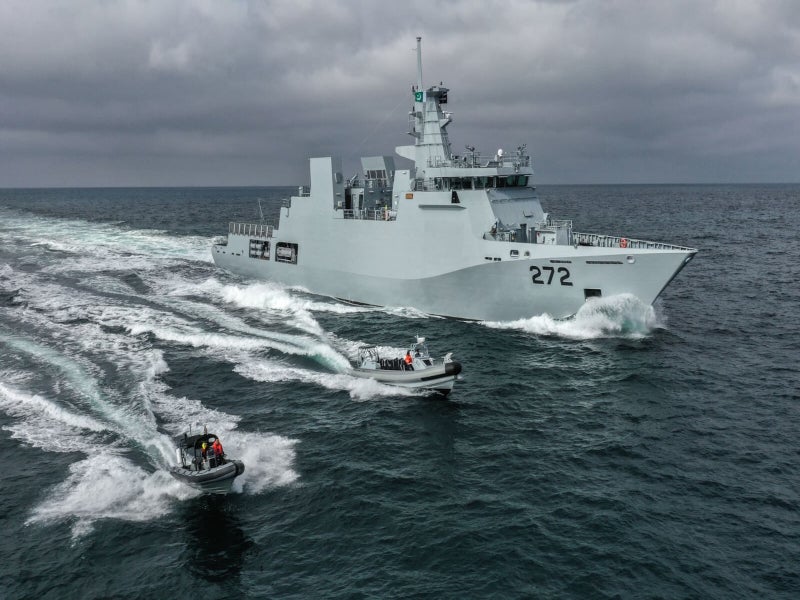Yarmook-class offshore patrol vessels (OPVs) are being developed at Damen Shipyards Galati in Romania, for use by the Pakistan Navy.
The corvettes offer capabilities for a wide variety of maritime operations in a complex environment. They are suitable for anti-surface and anti-air operations, search and rescue, as well as maritime surveillance and security.
The vessels will serve as force multipliers and offer more flexibility to the Pakistan Navy for its Regional Maritime Security Patrols in the Indian Ocean.
Yarmook-class OPVs orders and deliveries
The Yarmook programme involved the purchase of OPV-1900 ships from Dutc shipbuilders Damen and converting them into corvettes based on the specific military requirements of the Pakistan Navy, including weapons systems and subsystems up to a total tonnage of 2,300 tonnes (t).
Damen delivered two vessels, namely the PNS Yarmook (271) and PNS Tabuk (272), to Pakistan in Batch I, as part of an initial contract with the Islamic Republic of Pakistan’s Ministry of Defence Production, signed in 2017.
PNS Yarmook was commissioned by the Pakistani navy in February 2020, while the second vessel PNS Tabuk joined the fleet in November 2020.
The navy ordered two additional bigger OPV-2600 multi-mission patrol vessels in Batch II, with a larger tonnage of at least 2,600t. The keel laying for the first ship and steel cutting ceremony for the second ship in the batch took place in October 2022.
The two bigger OPVs are expected to be delivered sometime in 2024.
PNS Yarmook and PNS Tabuk design and features
PNS Yarmook and PNS Tabuk measure 91.3 metres (m) long and 14.4m wide. The vessels have a draught of 4m and can complement a crew of 46. They can displace 2,300t of water, sail at a maximum speed of 23 knots up to a range of 6,000nm, and endure at sea for 40 days.
The OPVs feature facilities for mission-specific containers and can accommodate two fast rigid hull inflatable boats (RHIBs) and a Damen Inboard RHIB 1125. They are highly adaptable platforms capable of launching a helicopter, an unmanned aerial vehicle (UAV), and two RHIBs simultaneously.
Damen Inboard RHIB 1125 details
Damen Inboard RHIB 1125 measures 11.25m long, 3.35m wide, and has a draught of 0.75m.
The boat is built of solid materials for heavy-duty tasks and offers high manoeuvrability. It features a computer fluid dynamic designed hull for optimal speed and is equipped with a variety of propulsions, including a sterndrive, waterjets or outboards.
The boat can reach a maximum speed of more than 40 knots. It can accommodate 13 crew members on Ullman Dynamics’ Biscaya Mk3 BD HN seats.
The vessels are equipped with a close-in weapon system (CIWS), anti-ship missiles, a 30mm gun and 12.7mm heavy machine guns.
OPV 2600 design and features
OPV 2600 vessels will be 98m long and 14.6m wide with a displacement of 2,600t. They will have a draught of 4m and will be capable of accommodating up to 120 crew members.
The vessels will feature two RHIBs, one measuring 11.25m and another 6.5m in length. They will also have a helicopter deck and hangar.
The OPVs will be able to sail at speeds ranging between 22 knots and 25 knots up to a range of 5,000nm and have an endurance of 40 days. The vessels will feature advanced communication systems and will be equipped for extended range and performance.
Armaments aboard OPV 2600
The increased tonnage of the vessels will facilitate them to be equipped with extensive weapons suites, including a main gun of up to 76mm together with other secondary and smaller guns.
The vessels will feature the capacity for five additional mission modules, such as a side scan sonar for anti-submarine warfare, mine countermeasures for ships, UAV, pollution control, hospital facilities, diving support, as well as energy and water-making facilities and more.
The OPVs will feature Gokdeniz or Phalanx CIWS anti-air missile systems, and a vertical launching system cell for surface-to-air missiles.
In addition, they will be fitted with an Aselsan Smart-S MK2 active electronically scanned array radar, Aselsan Stamp lightweight remote-controlled weapon station for a main naval cannon, two Harbah tri-cell dual-use anti-ship/land-attack cruise missile launchers with a range of 750km, and two triple-cell torpedo launchers.
Furthermore, the vessels will be integrated with advanced low-probability-of-intercept radars, a modern electronic warfare suite, electronic intelligence/electronic support measures, and a close-range acoustic weapon.
The rest of the capabilities will remain the same as the smaller Yarmook vessels.
Propulsion systems
Yarmook-class corvettes are powered by four Caterpillar 3516 diesel engines in its combined diesel and diesel configuration, and two controllable pitch propellers.










